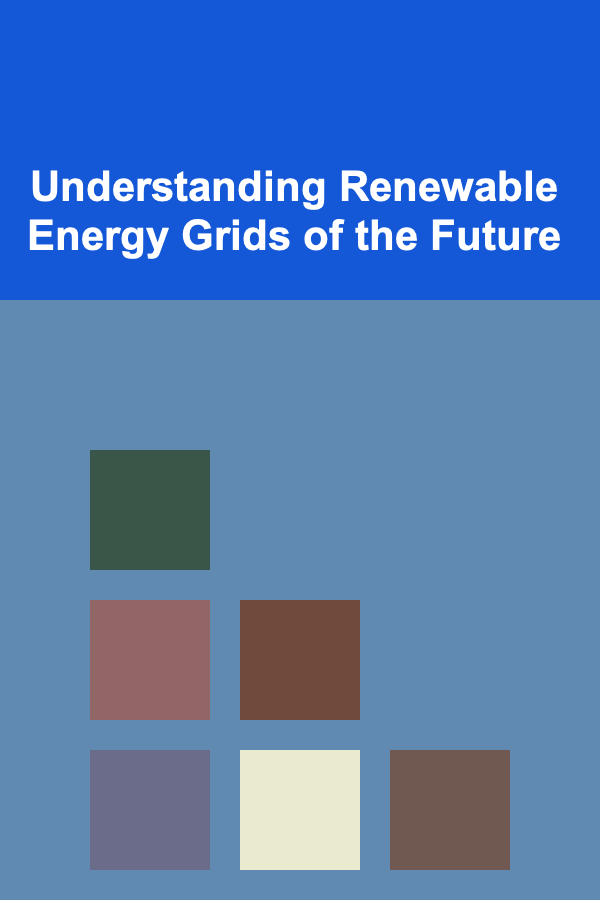
Understanding Renewable Energy Grids of the Future
ebook include PDF & Audio bundle (Micro Guide)
$12.99$6.99
Limited Time Offer! Order within the next:

The future of energy is undoubtedly renewable. As concerns about climate change escalate and the costs of renewable energy technologies plummet, the transition from fossil fuels to cleaner sources is accelerating. However, simply replacing coal-fired power plants with solar farms or wind turbines isn't enough. A profound transformation is needed in how we design, manage, and operate our electricity grids. This article delves into the complexities of understanding renewable energy grids of the future, exploring the key technologies, challenges, and opportunities that lie ahead.
The Need for a Paradigm Shift
Traditional electricity grids were designed for a centralized model, with large power plants generating electricity and transmitting it over long distances to consumers. This model worked well for decades, but it's inherently inflexible and ill-suited for the characteristics of renewable energy. Renewable sources, such as solar and wind, are inherently variable and intermittent. The sun doesn't always shine, and the wind doesn't always blow. Integrating these variable sources into the grid requires a fundamental rethinking of how the system operates.
Furthermore, the traditional grid is largely passive, with electricity flowing in one direction from generators to consumers. Renewable energy encourages a more distributed and active model, with consumers becoming prosumers, generating their own electricity and feeding excess power back into the grid. This decentralization presents both challenges and opportunities for grid management.
Key Technologies Enabling the Renewable Energy Grid
Several key technologies are crucial for enabling the integration of renewable energy sources into the future grid. These technologies address the challenges of variability, intermittency, and decentralization.
1. Advanced Energy Storage
Energy storage is arguably the most critical technology for a renewable energy future. It addresses the fundamental problem of intermittency by storing excess electricity generated during periods of high renewable output and releasing it when demand is high or renewable generation is low. Various energy storage technologies are emerging, each with its own strengths and weaknesses:
- Lithium-ion Batteries: Currently the dominant technology for short-duration storage (minutes to hours). Lithium-ion batteries are relatively mature, efficient, and have declining costs, making them suitable for applications such as grid stabilization, peak shaving, and electric vehicle charging. However, their limited duration and concerns about resource availability and safety are drawbacks.
- Flow Batteries: Offer longer duration storage (hours to days) compared to lithium-ion batteries. Flow batteries store energy in liquid electrolytes, allowing for independent scaling of power and energy capacity. They are generally safer than lithium-ion batteries but have lower energy density and higher upfront costs. They are increasingly being considered for grid-scale applications.
- Pumped Hydro Storage: A mature and well-established technology for large-scale, long-duration energy storage. Pumped hydro involves pumping water uphill to a reservoir during periods of excess electricity and releasing it through turbines to generate electricity when needed. While highly efficient and long-lasting, pumped hydro requires specific geographic conditions and can have environmental impacts.
- Compressed Air Energy Storage (CAES): Stores energy by compressing air and storing it in underground caverns or tanks. The compressed air is then released to drive turbines and generate electricity. CAES offers long-duration storage and can be sited in various locations, but it requires geological formations suitable for air storage and can have lower efficiency compared to other storage technologies.
- Thermal Energy Storage: Stores energy in the form of heat or cold. Thermal energy storage can be used for various applications, including solar thermal power plants, district heating and cooling systems, and industrial processes. It can be a cost-effective option for applications where heating or cooling is a significant energy demand.
- Hydrogen Energy Storage: Emerging as a long-duration energy storage solution, particularly for seasonal storage. Electrolyzers use electricity to split water into hydrogen and oxygen. The hydrogen can then be stored and used in fuel cells to generate electricity, used in industrial processes, or blended with natural gas. Hydrogen energy storage is still in the early stages of development, but it has the potential to play a significant role in decarbonizing various sectors.
The optimal mix of energy storage technologies will depend on specific grid conditions, regional resources, and cost considerations. Further research and development are needed to improve the performance, reduce the cost, and enhance the safety of all energy storage technologies.
2. Smart Grids and Advanced Metering Infrastructure (AMI)
Smart grids are essential for managing the complexity and variability of renewable energy sources. They utilize advanced sensors, communication networks, and control systems to monitor and optimize the flow of electricity in real-time. AMI, a key component of smart grids, provides two-way communication between utilities and consumers, enabling:
- Real-time Monitoring: Utilities can track electricity demand and generation across the grid in real-time, allowing for better forecasting and resource allocation.
- Demand Response: Consumers can respond to price signals or incentives to adjust their electricity consumption during peak periods, reducing stress on the grid and lowering costs.
- Automated Meter Reading: Eliminates the need for manual meter reading, improving efficiency and accuracy.
- Remote Disconnect/Reconnect: Enables utilities to remotely disconnect or reconnect customers, improving response times to outages and facilitating grid management.
- Improved Grid Stability: Smart grid technologies can detect and respond to grid disturbances more quickly, preventing cascading failures and improving overall grid stability.
Smart grids also enable the integration of distributed energy resources (DERs), such as rooftop solar panels and electric vehicle chargers. Advanced control systems can manage these DERs to optimize grid performance and provide ancillary services, such as frequency regulation.
3. Power Electronics and Inverters
Renewable energy sources, such as solar and wind, generate electricity in direct current (DC). However, the electricity grid operates on alternating current (AC). Power electronics, particularly inverters, are essential for converting DC electricity to AC electricity and synchronizing it with the grid. Advanced inverters can also provide grid support functions, such as voltage regulation and frequency control.
The development of wide-bandgap semiconductors, such as silicon carbide (SiC) and gallium nitride (GaN), is revolutionizing power electronics. These materials offer higher efficiency, higher switching speeds, and higher temperature capabilities compared to traditional silicon-based semiconductors. This allows for smaller, lighter, and more efficient inverters, which are crucial for integrating renewable energy sources into the grid.
4. Artificial Intelligence (AI) and Machine Learning (ML)
AI and ML are playing an increasingly important role in managing the complexity of renewable energy grids. These technologies can be used for:
- Improved Forecasting: ML algorithms can analyze historical data, weather patterns, and other factors to improve the accuracy of renewable energy generation forecasts. This allows utilities to better plan for fluctuations in renewable output and dispatch other resources accordingly.
- Optimized Grid Operation: AI can be used to optimize the operation of the grid in real-time, balancing supply and demand, minimizing losses, and maximizing the use of renewable energy.
- Predictive Maintenance: ML algorithms can analyze sensor data from grid equipment to predict potential failures and schedule maintenance proactively, reducing downtime and improving reliability.
- Cybersecurity: AI can be used to detect and prevent cyberattacks on the grid, protecting critical infrastructure from disruption.
- Demand Response Optimization: AI can be used to personalize demand response programs, tailoring incentives and strategies to individual consumer needs and preferences.
The use of AI and ML in grid management is still in its early stages, but it holds enormous potential for improving the efficiency, reliability, and resilience of renewable energy grids.
5. Microgrids and Distributed Generation
Microgrids are localized energy grids that can operate independently or in conjunction with the main grid. They typically include a mix of renewable energy sources, energy storage, and conventional generators. Microgrids offer several benefits:
- Enhanced Resilience: Microgrids can continue to operate even during grid outages, providing a reliable source of power to critical facilities such as hospitals and emergency services.
- Reduced Transmission Losses: Generating electricity closer to the point of consumption reduces transmission losses, improving overall efficiency.
- Increased Renewable Energy Integration: Microgrids can facilitate the integration of renewable energy sources by providing a local market for excess generation.
- Improved Power Quality: Microgrids can improve power quality by providing voltage and frequency support.
Distributed generation (DG) refers to electricity generated at or near the point of consumption. DG can include rooftop solar panels, small wind turbines, combined heat and power (CHP) systems, and other sources. DG can reduce reliance on the main grid, lower energy costs, and improve energy security.
Challenges in Building the Renewable Energy Grid
While the transition to a renewable energy grid offers significant benefits, it also presents several challenges:
1. Intermittency and Variability
As mentioned earlier, the intermittency and variability of renewable energy sources are major challenges for grid operators. The output of solar and wind farms can fluctuate rapidly due to changes in weather conditions. This can make it difficult to balance supply and demand and maintain grid stability. Accurate forecasting, advanced energy storage, and flexible grid resources are crucial for mitigating these challenges.
2. Grid Modernization Costs
Modernizing the grid to accommodate renewable energy sources requires significant investments in new infrastructure, including smart meters, communication networks, and advanced control systems. These costs can be a barrier to adoption, particularly in developing countries. Innovative financing mechanisms and government policies are needed to accelerate grid modernization efforts.
3. Siting and Permitting
Building new renewable energy projects and transmission lines can be challenging due to siting and permitting issues. Communities may resist new projects due to concerns about aesthetics, environmental impacts, or property values. Streamlining the permitting process and engaging with communities early in the planning process are essential for overcoming these challenges.
4. Cybersecurity Risks
As the grid becomes more digitized, it becomes more vulnerable to cyberattacks. Cyberattacks can disrupt grid operations, cause power outages, and compromise sensitive data. Robust cybersecurity measures are needed to protect the grid from these threats. This includes implementing strong authentication protocols, monitoring network traffic for suspicious activity, and developing incident response plans.
5. Regulatory and Market Barriers
Existing regulations and market structures may not be well-suited for a renewable energy grid. For example, some regulations may favor incumbent fossil fuel generators or discourage the adoption of distributed energy resources. Reforming regulations and market structures to promote renewable energy and create a level playing field is essential for accelerating the transition to a cleaner energy future.
Opportunities and Future Directions
Despite the challenges, the transition to a renewable energy grid presents enormous opportunities:
1. Economic Growth and Job Creation
The renewable energy industry is a rapidly growing sector, creating new jobs in manufacturing, installation, operation, and maintenance. Investing in renewable energy and grid modernization can stimulate economic growth and create new opportunities for workers.
2. Energy Independence and Security
Renewable energy sources are domestically available in most countries, reducing reliance on imported fossil fuels and improving energy security. Diversifying the energy mix and reducing dependence on volatile global energy markets can protect consumers from price shocks and geopolitical risks.
3. Environmental Benefits
Renewable energy sources produce little to no greenhouse gas emissions, helping to mitigate climate change and improve air quality. Transitioning to a renewable energy grid can significantly reduce carbon emissions and contribute to a more sustainable future.
4. Improved Grid Reliability and Resilience
Smart grids and microgrids can improve grid reliability and resilience by providing distributed generation, energy storage, and advanced control systems. These technologies can help to prevent cascading failures and ensure a reliable supply of power even during extreme weather events or other disruptions.
5. Technological Innovation
The transition to a renewable energy grid is driving innovation in a wide range of technologies, including energy storage, power electronics, AI, and materials science. Continued investment in research and development will accelerate the development of new technologies and drive down the cost of renewable energy.
Conclusion
Understanding renewable energy grids of the future requires a holistic perspective, encompassing technological advancements, economic considerations, regulatory frameworks, and societal implications. While significant challenges remain, the opportunities presented by a cleaner, more reliable, and more sustainable energy system are immense. By embracing innovation, fostering collaboration, and implementing smart policies, we can build a renewable energy grid that powers a brighter future for all.
The journey towards a fully renewable energy grid is a complex and ongoing process. It requires sustained effort from governments, industry, researchers, and consumers. By working together, we can overcome the challenges and realize the enormous potential of renewable energy to transform our energy system and create a more sustainable world.
This transformation isn't just about replacing old technology with new; it's about fundamentally changing the way we think about and interact with energy. It's about empowering individuals and communities to become active participants in the energy system, driving innovation and creating a more resilient and equitable energy future.

How to Build a Checklist for Preventive Car Maintenance
Read More
How to Maintain Holiday Decorations Year After Year
Read More
How to Store Cleaning Supplies in a Convenient Yet Tidy Way
Read More
How to Build a Positive Dating Mindset
Read More
Developing Emotional Intelligence: A Comprehensive Guide
Read More
10 Tips for Handling Error States in Voice User Interfaces
Read MoreOther Products

How to Build a Checklist for Preventive Car Maintenance
Read More
How to Maintain Holiday Decorations Year After Year
Read More
How to Store Cleaning Supplies in a Convenient Yet Tidy Way
Read More
How to Build a Positive Dating Mindset
Read More
Developing Emotional Intelligence: A Comprehensive Guide
Read More